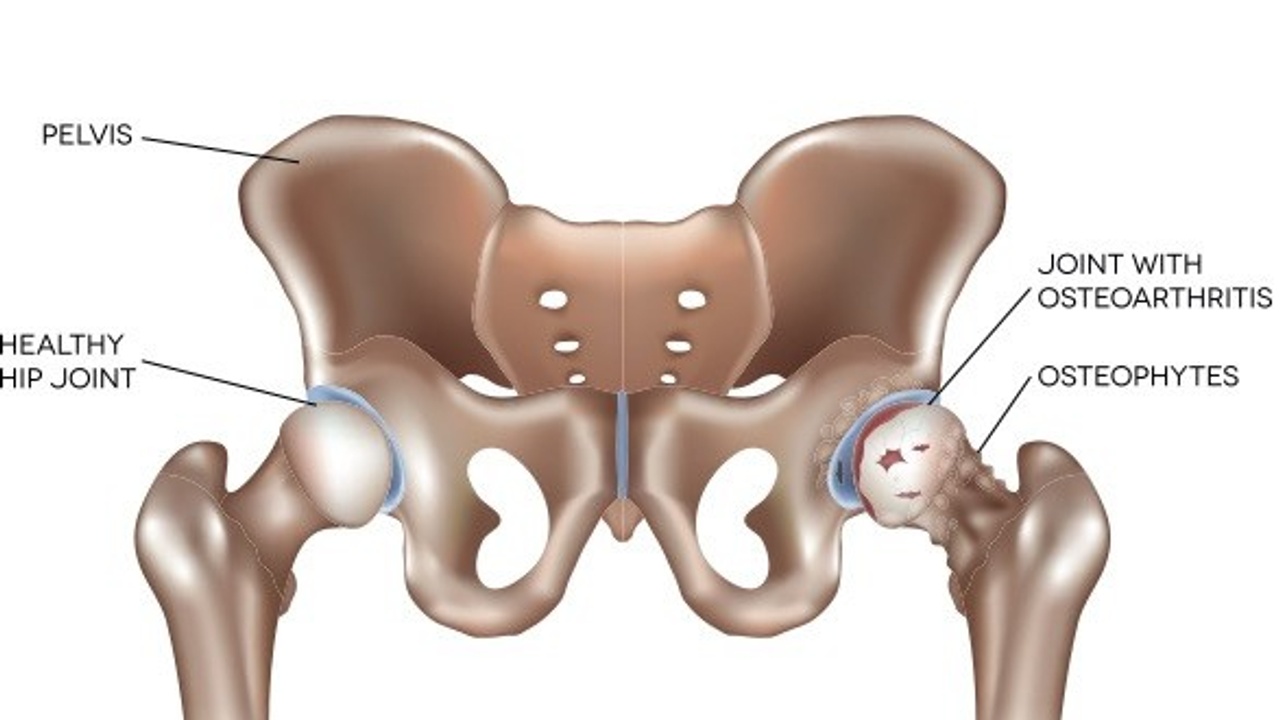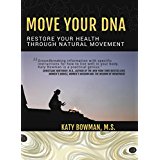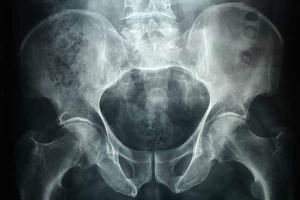Osteoarthritis is a Symptom of Postural Misalignments
Aug 24, 2016
At 38, my doctor diagnose me with severe (grade 4) bone-on-bone left hip osteoarthritis. Since I was too young for a joint replacement, he advised me to reduce my activity level and avoid any movements that hurt. When the pain was excruciating enough, and my activity limited enough, they would consider me for a new artificial hip.
Osteoarthritis is a thinning of the cartilage within your joints that creates symptoms of pain, swelling, and stiffness. The image to the right shows a left hip that has osteoarthritis. The osteophytes labeled in the image are bone growths. These growths often accompany cartilage degeneration. Even though most people don't realize this, aging does not always mean that you'll have osteoarthritis. You can overcome it without drastic surgery.
What I want you to most consider about this image is why does only one hip have osteoarthritis?
Why did that hip alone become bone on bone?
We often accept that osteoarthritis causes our pain, and that's the reason why we need a hip replacement. But we fail to consider why the hip cartilage broke down in the first place. This is understandable. We just want to move forward with a treatment plan that will eliminate the pain. However, aren’t you just a bit curious about why only one hip was affected?Or how you might prevent this from happening on the other side? I was! I wanted to know what was different about my left hip from my right that contributed to my joint's degeneration.

In her book, Move Your DNA, movement biomechanist Katy Bowman explains, “Every unique joint configuration, and the way that joint configuration is positioned relative to gravity, and every motion created, and the way that motion was initiated, creates a unique load that in turn creates a very specific pattern of strain in the body.” So, movement generates load and strain on your joint structures. And how your hip, or any joint, is positioned--aligned or askew--determines that load.
The image above is slightly misleading, though. The pelvis looks like it's perfectly symmetrical. All three bones of the pelvis--right and left hip bone and sacrum--are aligned. Also, the femurs are balanced without rotation.
In my experience, however, clients with hip joint deterioration do not have a neutral and level pelvis or femurs. Instead, their structure look s something more like the image to the right. In this view of the pelvis, you can see that the right hip bone is higher. Also, the right hip joint looks bigger and closer to the screen, which indicates some possible pelvis and/or femur rotation. And, the bottom holes in the pelvis are slightly asymmetrical, indicative of a pelvic tilt disparity. What's the cause? Each of the three bones on the pelvis can move separately and can become fixed in an unbalanced position. When this happens, it alters movement and thus can cause joint deterioration. This is what happened to my hips: The left hip was positioned in a more compromised posture.
s something more like the image to the right. In this view of the pelvis, you can see that the right hip bone is higher. Also, the right hip joint looks bigger and closer to the screen, which indicates some possible pelvis and/or femur rotation. And, the bottom holes in the pelvis are slightly asymmetrical, indicative of a pelvic tilt disparity. What's the cause? Each of the three bones on the pelvis can move separately and can become fixed in an unbalanced position. When this happens, it alters movement and thus can cause joint deterioration. This is what happened to my hips: The left hip was positioned in a more compromised posture.
When the bones are not in proper position, stress and friction develop within the joint with motion, which wears away the delicate soft tissues. When my doctors diagnosed me, they said I had a hole in my hip. This was because my misaligned hip bone had worn through the cartridge in one spot. To illustrate, if you take your fist, put it in the palm of your opposite hand, and continually rub the same spot, eventually the skin will turn red, then bleed, and so on. Clearly, to fix the problem, you'd stop rubbing the same spot.
So, in order to remove the continued stress on my cartilage, I had to move my hip and femur bones. This would take away the pressure and continued damage. Because the muscles and soft tissues position the bones, any muscle imbalances can create postural asymmetries. Therefore, if you do corrective alignment exercises, which move the bones, you can relieve the symptoms of osteoarthritis. In other words, misaligned posture causes the joint’s decay. And just like any other structure in the body, cartilage can regenerate if the environment is suitable. How do you do that? Just stop the continued rubbing from the bone.
Here's some good news! Since I started working on correcting my alignment, I have not had a joint replacement. And, I no longer have debilitating hip pain. Instead, I have strengthened my body and gained confidence in its capacity to heal and support my athletic and everyday activities. After four joint surgeries, all on the left side, three knee and one hip arthroscopy, I am no longer anticipating the further decline of my body. And actually, I now enjoy greater resilience.
When you think about your treatment options for osteoarthritis, consider the most basic first: your structural alignment. If you correct your posture, you can alleviate your symptoms without drugs, injections, or surgery! Isn’t that worth a try?
Stay connected with news and updates!
Join our mailing list to receive the latest news and updates from me.
Don't worry, your information will not be shared.
We hate SPAM. We will never sell your information, for any reason.

